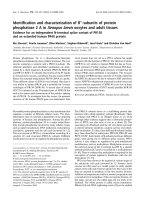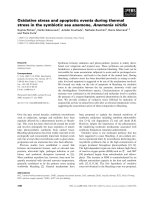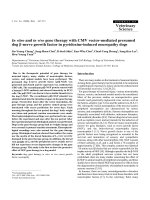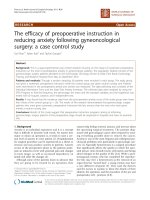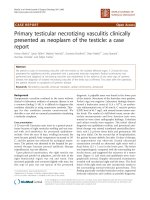báo cáo khoa học: "Acute hepatocellular and cholestatic injury during therapy with hydrochlorothiazide clinicohistopathologic findings: a case report" potx
Bạn đang xem bản rút gọn của tài liệu. Xem và tải ngay bản đầy đủ của tài liệu tại đây (396.9 KB, 4 trang )
CAS E REP O R T Open Access
Acute hepatocellular and cholestatic injury during
therapy with hydrochlorothiazide -
clinicohistopathologic findings: a case report
Fabrizio Taglietti
1*
, Franca Del Nonno
2
, Andrea Baiocchini
2
, Laura Falasca
3
, Stefano Pieri
4
, Alessandro Capone
1
,
Elisabetta Grilli
1
, Pierangelo Chinello
1
, Nicola Petrosillo
Abstract
Introduction: Hydrochlorothiazide and thiazide-like diuretics are considered first-line drugs for initial therapy in
uncomplicated arterial hypertension. Acute cholecystitis is a well-known complication during treatment with
thiazide, and these drugs are also reported to be followed by pronounced insulin resistance.
Case presentation: We describe a case of acute cholestatic hepatitis in a 68-year-old Caucasian man who was
receiving olmesartan and hydrochlorothiazide for arterial hypertension. From the clinical and histologic findings, we
diagnosed him as having hepatocellular-cholestatic injury and a disorder of glucose metabolism in the liver. To the
best of our knowledge, no histopathologic description of hydrochlorothiazide hepatotoxicity has previously been
documented in the literature.
Conclusion: In the differential diagnosis of cholestatic hepatitis, clinicians should be aware of the possibility of liver
damage in patients receiving hydrochlorothiazide therapy.
Introduction
Thiazide diuretics are first-line and low-cost drugs used
to treat uncomplic ated arterial hypertension [1]. They
were originally synthesized in an effort to enhance the
potency of inhibitors of carbonic anhydrase. However,
unlike carbonic anhydrase inhibitors, which primarily
increase Sodium Bicarbonate (NaHCO
3)
excretion, thia-
zides were found predominantly to increase Sodium
Chloride (NaCl) excretion, an effect shown to be i nde-
pendent of carbonic anhydrase inhibition.
The major concerns about their use arise from their
tendency to cause hypokalemia, impair glucose toler-
ance, and increase serum cholesterol and uric acid.
Similar to loop diuretics, the most serious adverse
events are related to abnormalities of fluid and electro-
lyte balance [2].
The most common adverse events of thiazide diuretics
include vertigo, headache, paresthesias, xanthopsia,
weakness, anorexia, nausea, vomiting, cramping, diar-
rhea, constipation, cholecystitis, pancreatitis, blood dys-
crasias, photosensitivity, and skin rashes [2-7].
Thiazide diuretics also decrease glucose tolerance, and
latent diabetes mellitus may be unmasked during ther-
apy. The mechanism behind the impai red glucose toler-
ance is not completely understood, but appears to
involve reduced insulin secretion and alterations in glu-
cose metabolism [8].
Thiazide diuretics also may increase plasma levels of
low-density lipoprotein cholesterol, total cholesterol, and
total triglycerides. Hepatotoxicity by hydrochlorothiazide
(HCTZ) therapy is an uncommonly adverse event rarely
described, and only clinically [9].
We describe a clinical case of HCTZ-induced acute
cholestatic hepatitis associated to alterations of the glu-
cose metabolism inside the liver.
Case presentation
A 68-year-old Caucasian man was admitted to our
Infectious Diseases Unit with a ten-day history of jaun-
dice, asthenia, nausea, vague right upper quadrant
abdominal pain and hyperchromic urine. Twenty days
* Correspondence:
1
II Division of Infectious Diseases, Istituto Nazionale per le Malattie Infettive,
Istituto di Ricovero e Cura a Carattere Scientifico ‘Lazzaro Spallanzani’,Rome,
Italy
Full list of author information is available at the end of the article
Taglietti et al. Journal of Medical Case Reports 2010, 4:332
/>JOURNAL OF MEDICAL
CASE REPORTS
© 2010 Taglietti et al; licensee BioMed Central Ltd. This is an Open Access article distribute d under the terms of the Creative Commons
Attribu tion License (http:// creativecommons.org/licenses/by/2.0), which permits unrestricted use, dis tribution, and reproduction in
any medium, provided the origina l work is properly cited.
previously, while on treatment with ramipril, the patient
consulted his general practitioner because of recent
onset of high systolic arterial pressure value. Treatment
with ramipril was stopped, and olmesartan 10 mg and
HCTZ 12.5 mg were started. At this time, our patient’s
clinical and routine laboratory findings were normal.
On admission to our hospital, the patient appeared
asthenic. On physical examination, we found the patient
to have a normal body mass index, vague right upper
quadrant abdominal pain, sclera icterus and mild hepa-
tomegaly. The remainder of the clinical examination
was unremarkable. Other than the arterial hypertension,
he had no medical history of note.
Liver function test results showed: alanine aminotrans-
ferase (ALT) 346 U/L (normal < 40 U/L), aspartate ami-
notransferase (AST) 158 U/L (< 40 U/L), gamma
glutamine transferase (GGT) 250 U/L (< 64 U/L),
C-reactive protein 0.70 mg/dL (< 0.60 mg/dL), alkaline
phosphatase 1.091 U/L ( normal range 91 to 258 U/L),
total bilirubin 6.28 mg/dL (0.2 to 1 mg/dL), direct bilir-
ubin 4.26 mg/dL (0.01 to 0.2 mg/dL), ferritin 647 ng /dL
(15 to 400 ng/dL). Results of red and white blood cell
counts, platelet counts, and other laboratory tests were
normal.
Results of tests for possible infectious causes of hepati-
tis showed that our patient was negative for cytomegalo-
virus (CMV) IgM, parvovirus B19 IgM and IgG, and
Epstein-Barr viral capsid antigen (EBV VCA) IgM, and
positive for CMV IgG and EBV VCA IgG positive.
Blood cultures, and antibody tests for human immuno-
deficiency virus, hepatitis A, B, C and E viruses, hepatitis
surface antigen, and leptospira were negative. Our
patient’s immunoglobulin levels were normal. Antinuc-
lear autoantibody, anti-microsomal antibodi es, anti-
smooth muscle antibodies, anti-liver-kidney-microsomal
antibodies, anti-neutrophil cytoplasmic a ntibody, and
anti-glomerular basement membrane were undetectable.
Screening for tumor-associated antigens was also
negative.
Abdominal untrasonography, abdomen computed
tomography, and magnetic resonance cholangiography
were performed to assess the presence of solid tumors
or bile duct obstruction; the results rev ealed on ly a mild
hepatomegaly.
By day 18, our p atient was still jaundiced and had
scleral icterus. His clinical condition was unchanged.
Repeat laboratory investigations showed an increase in
total bilirubin (14.7 mg/dL), with direct bilirubin at 12.6
mg/dL. AST and ALT values were slightly diminished
(100 and 170 U/L respectively), and alkaline phospha-
tase and GGT had decreased to 428 U/L and 170 U/L,
respectively (Table 1).
Because of our patient’s persistent higher transaminase
and bilirubin values, and the negative findings on
laboratory and radiologic testing, the clinical picture was
attributed to primary toxic damage by HCTZ. Therapy
with olmesartan plus HCTZ was t hen stopped; enalapril
10 mg twice daily was started. Using percutaneous nee-
dle biopsy, a liver sample was obtained, fixed in 10%
buffered formalin, and embedded in paraffin wax for
routine histolog ic examination. Slides were stained with
hematoxylin and eosin, periodic acid-Schiff (PAS), PAS
diastase, Perl, reticulin s ilver i mpregnation, and Masson
trichrome.
Histologic evaluation of the liver sample was per-
formed by two pathologists. There was evidence of
acute cholestatic hepatitis. The p erivenular hepatocytes
were swollen, with feathery degeneration. Bile thrombi
in dilated canaliculi (canalicular cholestasis) were also
seen throughout the acinus (Figure 1). Doubling of the
hepatic trabeculae with anisokaryosis and formation of
several liver cell rosettes, features that were most appar-
ent in zone three, were considered features of re genera-
tion. A mild hepatic necroinflammatory mixed infiltrate
was present in all three zones of the acinus, in the form
of spotty necrosis and occasionally confluent necrosis.
There was accumulation and enlargement of Kupffer
Table 1 Trend of liver function tests
Blood test Day
Day 0 18
1
22 30 90
ALT (U/L)
2
346 170 100 76 20
AST (U/L)
2
158 100 96 58 14
Total bilirubin (mg/dL) 6.28 14.7 10.6 6 0.2
Direct bilirubin (mg/dL) 4.26 12.6 8.4 4.1 0.1
Alkaline phosphatase (U/L) 1.09 428 340 298 146
GGT (U/L)
2
250 170 140 98 12
1
HCTZ therapy stopped.
2
ALT = alanine amino-transferase; AST = aspartate
amino-transferase; GGT = gamma glutammin transferase.
Figure 1 Marked cytoplasmic c analicular cholestasis
(hematoxylin and eosin).
Taglietti et al. Journal of Medical Case Reports 2010, 4:332
/>Page 2 of 4
cells, many o f them forming discrete clumps in zone
three. They contained yellow-brown ceroid pigment,
staining with PAS after diastase digestion. The portal
tract s were ex panded and slightly oedematous, and con-
tained a moder ate inflammatory cell infiltrate composed
of lymph ocytes and neutrophils, with many eosinophils
and histiocytes. Focal interface hepatitis was present in
some portal tracts. The interlobular bile ducts were pre-
served, and ductular react ion was evident at the edge of
portal tracts. Zone one hepatocytes were swollen, and
staining was pale. Glycogenated nuclei were present in
periportal hepatocytes (Figure 2). Finally, granules of
stai nable iron were seen in sinusoidal lining cells and in
periportal hepatocytes, associated with a more diffuse
staining indicative of ferritin deposits. Fatty changes and
Mallory-Denk bodies were not seen. Mild pericellular
fibrosis was present in perivenular areas.
By day 22, our patient’s transaminase and bilirubin
values were decreased and his clinical condition
improved. The glycemic index and insulin index were
normal. On day 30, the patient was discharged in good
clinical condition. His final blood results were: ALT 76
U/L, AST 58 U/L, alkaline phosphatase 298 U/L, total
bilirubin 6.0 mg/dL, direct bilirubin 4.1 mg/dL, GGT 98
U/L and C-reactive protein 0.10 mg/dL. At follow-up
examination on day 90, our patient was asymptomatic
and his liver blood tests gave n ormal results. The pat-
tern of blood test results is shown in Table 1.
Discussion
Cholestatic hepatitis has previously been reported in one
patient during HCTZ treatment [9]. In that paper, the
diagnosis of HCTZ- induced cholestatic liver injury was
based on the laboratory tests and the N aranjo probabil-
ity scale, indicating a possible relationship between the
drug and liver injury. However, to date no histopatholo-
gical description of the associated liver changes has
been reported, to the best of our knowledge, and our
case represents the first documentation of cl inical and
histopathological liver damage in the course of HCTZ
treatment.
In our patient we excluded an obstruction of the bili-
ary tract (for example, hepatic and pancreatic neo-
plasm, biliary calculosis), primitive biliary cirrhosis,
sclerosing cholangitis, autoimmune disorders of the
liver and infective causes for the i ncreased transami-
nase values, including viral hepatitis. Based on our
patient’s history and on his score o n the Naranjo prob-
ability scale, which indicated a probable relationship
between HCTZ and development of liver injury [10],
we suspected that his hepatic damage was probably
related to the HCTZ therapy. To confirm our hy poth-
esis, we examined a liver biopsy, which showed acute
hepatocellular-cholestatic injury associated with altera-
tions of glucose metabolism in the liver, which was
consistent with our clinical hypothesis of liver toxicity
by HCTZ.
Because a recent article [11] ha d demonstrated h ow
visceral fat redistribution, liver fat accumulation, low-
grade inflammation, and aggravate d insulin resista nce
are all adverse effects caused by HCTZ therapy, we
plotted a glycemic index and an insulin index for our
patient, which gave n ormal results. A possible explana-
tion for this was the concomitant treatment with olme-
sartan, which may prevent hyperglycemia [12]. In
addition, the HCTZ treatment duration was relatively
short (40 days), possibly too short to cause marked
alteration of glucose metabolism, and our patient had
no known risk factors for developing diabetes.
Conclusion
In conclusion, in the differential diagnosis of cholestatic
hepatitis, clinicians should be aware of the possibility of
liver damage in the course of HCTZ therapy.
Consent
Written informed consent was obtained from the patient
for publication of this case report and accompanying
images. A copy of the written consent is available for
review by the Editor-in-Chief of this journal.
Author details
1
II Division of Infectious Diseases, Istituto Nazionale per le Malattie Infettive,
Istituto di Ricovero e Cura a Carattere Scientifico ‘Lazzaro Spallanzani’, Rome,
Italy.
2
Department of Pathology, Istituto Nazionale per le Malattie Infettiv,
Istituto di Ricovero e Cura a Carattere Scientifico ‘Lazzaro Spallanzani’, Rome,
Italy.
3
Laboratory of Electr on Microscopy, Istituto Nazionale per le Malattie
Infettive, Istituto di Ricovero e Cura a Carattere Scientifico ‘Lazzaro
Spallanzani’, Rome, Italy.
4
Radiology Department, San Camillo-Forlanini
Hospital, Rome, Italy.
Figure 2 Mild portal tract edema with a light mixed
inflammatory cell infiltrate and periportal hyperglycogenated
nuclei (hematoxylin and eosin).
Taglietti et al. Journal of Medical Case Reports 2010, 4:332
/>Page 3 of 4
Authors’ contributions
FT monitored the patient during hospitalization, analyzed data from the
literature, and helped to write the article. FDN, AB and LF performed the
histologic examination of the liver biopsy. ST performed the liver biopsy. EG
was the major contributor in writing the manuscript. AC and PC performed
the follow-up consultations of the patient after discharge. NP reviewed the
manuscript. All authors read and approved the final manuscript
Competing interests
The authors declare that they have no competing interests.
Received: 16 March 2010 Accepted: 21 October 2010
Published: 21 October 2010
References
1. Chobanian AV, Bakris GL, Black HR, et al: The seventh report of the joint
national committee on prevention, detection, evaluation, and treatment
of high blood pressure. JAMA 2003, 289:2560-72.
2. Goodman & Gilman’s The Pharmacologic Basis of Therapeutics. Edited
by: Brunton L, Lazo J, Parker K , 11 2006.
3. Rosenberg L, Shapiro S, Slone D, et al: Thiazides and acute cholecystitis. N
Engl J Med 1980, 303:546-548.
4. Bourke JB, Langman MJ: Thiazide, diuretics, cholecystitis, and pancreatitis.
N Engl J Med 1981, 304:233-4.
5. Porter JB, Jick H, Dinan BJ: Acute cholecystitis and thiazides. New Engl J
Med 1981, 304:954-955.
6. Van der Linden W, Ritter B, Edlund G: Acute cholecystitis and thiazides. Br
Med J (Clin Res Ed) 1984, 289:654-5.
7. Angelin B: Effect of thiazide treatment on biliary lipid composition in
healthy volunteers. Eur J Clin Pharmacol 1989, 37:95-6.
8. Wilcox CS, Welch WJ, Shreiner GF, Belardinelli L: Natriuretic and diuretic
actions of a highly selective A1 receptor antagonist. J Am Soc Nephrol
1999, 10:714-720.
9. Arizon Z, Alexander P, Berner Y: Hydrochlorothiazide induced hepato-
cholestatic liver injury. Age and Aging 2004, 33:509-510.
10. Naranjo CA, Busto U, Sellers EM, et al: A method for estimating the
probability of adverse drug reactions. Clin Pharmacol Ther 1981,
30:239-245.
11. Eriksson JW, Jansson PA, Carlberg B, Hagg A, et al: Hydrochlorothiazide,
but not candesartan, aggravates insulin resistance and causes visceral
and hepatic fat accumulation. Hypertension 2008, 52:1030.
12. Kaihara M, Nakamura Y, Sugimoto T, Uchida HA, Norii H, Hanajama Y,
Makino H: Olmesartan and tenocapril prevented the development of
hyperglycemia and the deterioration of pancreatic islet morphology in
Otsuka-Lory-Evans-Tokushima fatty rats. Acta Med Okayama 2009,
63(1):35-41.
doi:10.1186/1752-1947-4-332
Cite this article as: Taglietti et al.: Acute hepatocellular and cholestatic
injury during therapy with hydrochlorothiazide - clinicohistopathologic
findings: a case report. Journal of Medical Case Reports 2010 4:332.
Submit your next manuscript to BioMed Central
and take full advantage of:
• Convenient online submission
• Thorough peer review
• No space constraints or color figure charges
• Immediate publication on acceptance
• Inclusion in PubMed, CAS, Scopus and Google Scholar
• Research which is freely available for redistribution
Submit your manuscript at
www.biomedcentral.com/submit
Taglietti et al. Journal of Medical Case Reports 2010, 4:332
/>Page 4 of 4



